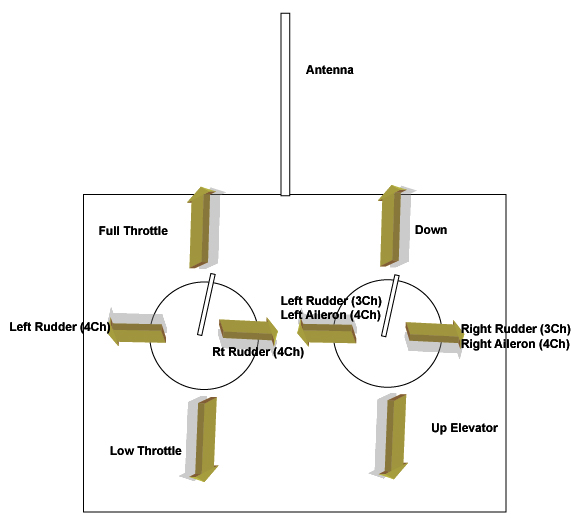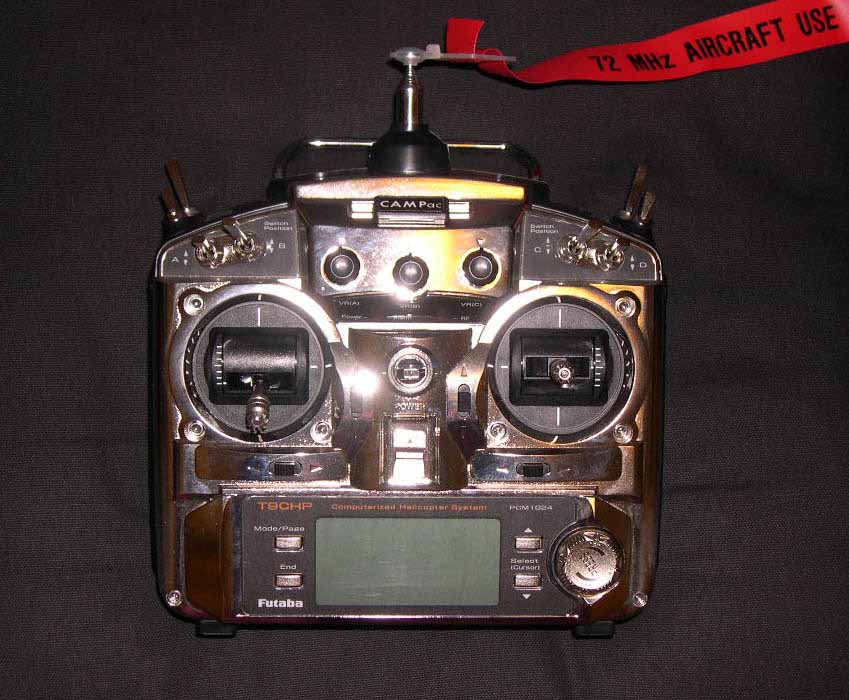Radio Control Systems and How they work
The radio control system is the heart of the RC airplane. Many people use these wonderful systems with hardly a thought as to how they work. Here is some info that could prove useful.
Every radio control system contains a transmitter (Tx) and receiver Rx). There are also actuators, or servo motors. The pilot uses the transmitter to send a radio command to the receiver.
The Rx then relays this command to the servo, which moves and also creates movement of the airplane surface to which it is connected.
Most modern rc systems feature proportional control, i.e. the amount of joystick movement at the Tx determines the amount of movement of the airplane's control surface.

The FCC (Federal Communications Commission) has designated certain
portions of the frequency band for radio control use. For example, 72MHz
designates the frequency band most often used for RC aircraft (50MHz is another,
but requires an amateur "ham" radio license). 75 MHz is used for rc cars and
boats. Note that the permitted frequencies vary from country to country.
That 72MHz is really not a single number, but designates a "band" of
frequencies that can be used. For example, one of the sub-frequencies is 72.030
MHz, also known as Channel 12.
It's vitally important that you know what channel your radio uses! Why?
Because switching on your Tx while someone else is flying on your channel will create radio interference for that person's aircraft, very likely resulting in a crash.
This unfortunate event is called a "shoot-down", and is a generally unpleasant event (not to mention unsafe). The model could have cost thousand of dollars or man-hours.
So, the first order of business when
you go flying should always be to check that no else is on your channel. Look at
the back of your radio for a frequency sticker, or check the box that it came
in.
Also note that radio control systems for planes should not be used
interchangeably with those for cars and boats. The reason is that surface models
and airborne models inhabit different regions of space.
Someone running a model
boat in a pond near your flying field is likely to be unaware of your airplane
(and you will be unaware of his or her boat.) Using separate frequency bands
helps reduce unnecessary incidents.
When buying your system, you will probably see the terms FM (frequency
modulation) and AM (amplitude modulation).
These are simply different
ways of transmitting a radio signal. FM tends to be less prone to interference,
and is generally a better choice for radio control of flying models, where the
cost of a radio error (glitch) could be high. AM is still a fine choice for
surface models.
You will probably buy a complete radio control system, either included with a
ready-to-fly plane, or as a separate package. If you do buy radio components
separately to save cost, be aware that a given transmitter is not compatible
with all receivers.
Both Tx and Rx need to be on the same channel. They also need to be both FM, or both AM. There is another distinction that makes different manufacturers systems incompatible with each other.
This is the
concept of "shift", which is one feature of the radio wave. Positive shift (JR,
Airtronics) is not compatible with Negative shift (Hitec, Futaba). Just
something to look out for if you are mixing and matching.
You will also see the terms 4-channel, 6-channel, etc. What is a channel and how many do you need?
In this case, channel is not referring to your radio frequency, but is referring to the number of separate radio functions that the system can handle at the same time.
The most basic radios available are two channel. These can work fine for
gliders, or some very basic powered aircraft.
My recommendation for beginners is to get at least a four channel radio
control system.
These may be more expensive than 2 or 3-channel, but they have more potential for your growth in the hobby.
Even if your trainer airplane only needs three functions (throttle, rudder, elevator), you will someday want the more advanced flying performance of a 4-channel airplane.
If you are
thinking that you are just trying the hobby, a 4-channel radio generally has a
higher resale value.
If you are already convinced that you will be staying with the hobby, and
perhaps someday build scale planes or fly helicopters, get the best radio you
can afford.
A good 7- or 9-channel radio can stay with your for many years. These have not only more channels, but many other useful features. These include mixing of channels, as well as the ability to store model configurations (memory).
You will not believe me when I tell you that you will use these
features someday, but it's likely to happen. Again, these more complex systems
have good resale value.
Once you have decided on number of channels, you still have a large number of
manufacturers to choose from.
Any of the major brands will work: Futaba, JR,
Hitec, Airtronics. I generally like Futaba systems, for their ease of use and
quality. Supporters of JR equipment will say the same thing. Hitec offers really
good value at lower prices; I especially like their components (receivers and
servos).
Whichever system you get, read the instructions carefully. Your typical 4
channel radio system will be setup as in the diagram above, depending on your
aircraft needs (3 function or 4 function).


